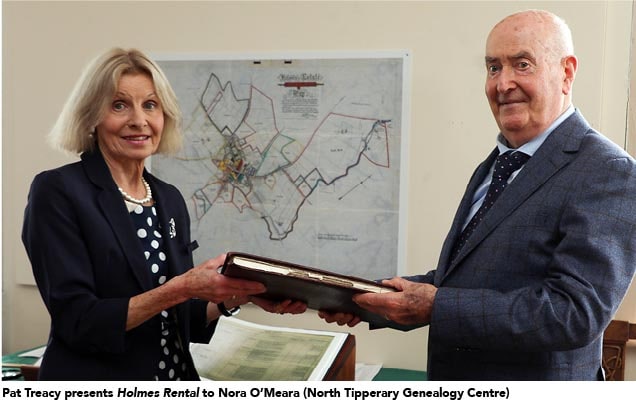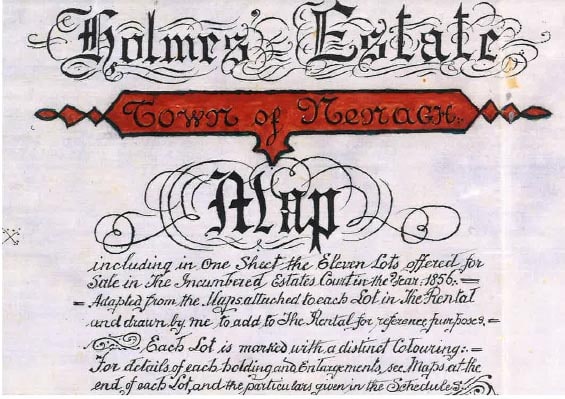
To the manor born
Occasionally, in the practice of conveyancing, one encounters a document that is fascinating. Patrick F Treacy looks at one such curiosity.
Some old documents can open to us a way of life that has faded from our collective memory. This can arise from the style of the document, its use of language, or from it providing an aperture into a whole way of living – a culture that has been forgotten.
One such document is the 62-page Holmes Rental, which is now on permanent public display at the Heritage Centre in Nenagh, Co Tipperary.
Although so named, it is in fact a contract document for the proposed public sale of the freehold interest or ground rents of 1,091 houses in Nenagh and its suburbs, and also in the lands of Farnamurry, owned by the Holmes Estate.
It would appear that, in 1856, the Court of the Commissioners for Sale of Incumbered Estates in Ireland, in accordance with its powers, arranged for the sale of the said property. The earliest document of title appears to have been a deed of 1721 in favour of Robert Holmes.
Included (as ‘Lot 1’) were the “Market House and Market Place, with the Beams, Weights, Scales, Tolls, Customs and Dues of Seven Fairs and Fifty-two Markets yearly, set to one tenant by Lease for one life at a yearly rent of £144-4s-8d Sterling.”
For whom the tolls bell
The tenant was named as Major John Hamilton Dundas, and it would seem that he was entitled, on paying this rent, not only to the use of the Market House, but also to charge tolls to farmers bringing in their livestock for sale on the streets of Nenagh.
It would be interesting to know how Major Dundas extracted these tolls from the unfortunate farmer who was being called upon to provide same but, pending further investigation, it can be assumed that he positioned a toll gatherer at each and every approach to the town, and that his yearly rent was well rewarded by the tolls collected and by his exclusive use of the Market House and Market Place.
It would appear that the rights, powers, and duties of both the lord and the tenant of the manor were governed, to a certain extent, by ancient laws or special customs.
In the case of approximately 80 of the properties being offered for sale, the proposed contract provided that the purchaser would be obliged “to do suit and service at the Courts Leet, and to grind corn at the Mill of Nenagh”.
The obligation in regard to the tenants’ corn is understandable, but that concerning suit and service at the Courts Leet is less than clear. Such courts have been defined as a yearly or half yearly court of record that the lords of certain manors held, but which appear to have been discontinued here a great many years ago.
They were a type of Memorial Court of England, Wales and Ireland that sat only a few times each year, sometimes just annually. Penalties were in the form of fine or even imprisonment.
Officers of Courts Leet were intended to provide the following and other services:
- Steward – a stand-in for the lord of the manor,
- Bailiff – responsible for ensuring that the decisions of the court were enacted,
- Constable – to ensure order during court sessions,
- Ale taster – to ensure the quality of ale and that true measures are used,
- Carniters or ‘flesh tasters’ – to ensure the freshness of meat and poultry,
- Bread weighers – responsible for verifying the freshness and weight of bread sold in the manor,
- Chimney peeper – to ensure chimneys were swept clean,
- Scavenger – to ensure standards of hygiene within the lanes and privies, and to try and prevent the spread of infectious diseases,
- Overseer of the poor – to collect and distribute alms,
- Chapelayne – who provided prayers for the court,
- Woodward – responsible for patrolling woodlands and stopping poachers from hunting illegally.
While it is amusing to read how everyday matters were managed when Courts Leet were in operation, we should bear in mind that we are, in fact, considering how public services were arranged in Nenagh in 1750 or thereabouts.

The services then being provided by the officers of Courts Leet were essential at that time – all of which are now undertaken by different Government departments, local authorities, An Garda Síochána, and the churches.
Memorial Courts and Courts Leet have ceased to have any jurisdiction in the United Kingdom to hear and determine legal proceedings, pursuant to the provisions of the Administration of Justice Act 1977, but in certain cases, the jurisdiction formerly exercised by these courts can be exercised instead by the High Court, the Crown Court, a County Court or a Magistrate’s Court.
Memorial Courts and Courts Leet operating in this State appear to have died a natural death ages ago.
Homes from Holmes
The sale of Holmes Estate properties was intended to take place at the Commissioners’ Court in Dublin by auction in 11 lots on 5 December 1856.
There is no information as to what happened on the day, but the reality of the situation is that no sale appears to have taken place, and the tenants continued to pay their rents. In the intervening years, however, it is likely that the majority of them acquired the Holmes Estate interest by private negotiation.
There is no doubt that hundreds of copies of the Holmes Rental, Maps and Particulars of Sale were prepared and distributed in 1856, but this copy, added to by the late Michael Gleeson, is unique in certain respects and, as such, is invaluable. Mr Gleeson, a solicitor, resided with his family in Summerhill, Nenagh. He was admitted to the solicitors’ profession in 1878.
For a period, he was honorary secretary of the Nationalist Association, and it was reported that, in the Land League days, “his services generously given, were sought by every tenant farmer in the county”. In 1895, he was appointed to the position of Crown Solicitor.
He held this office with distinction until 1922, when he resigned. The office was later abolished upon the setting up of the Irish Free State, and State Solicitors were appointed in their stead. Michael died on 26 December 1932.
The large number of properties forming the Holmes Estate were offered for sale in 11 lots, each of which had a separate chapter and map exhibiting the many different units comprising each lot. Michael Gleeson’s outstanding achievement was that, in 1931, he included on one parchment sheet all of the 11 lots.
Thus, when seeking title to a particular property, one would straightaway go to Mr Gleeson’s map and have immediate information in relation to the lot number in question – and have no need to check the other ten.

Mr Gleeson’s heading to the magnificent map prepared by him is a work of art in itself. It is reproduced above.
Following Michael’s death in 1932, the Holmes Rental was in the possession and care of his son Lewy, who died on 14 November 1960. After Lewy’s death, his nephew Dermot Gleeson passed it on to me (I had served a five-year apprenticeship with Lewy), probably in the expectation that it would stay in Nenagh.
On reading Michael Gleeson’s beautifully written preface to his Holmes Estate map, one cannot but be impressed by the evident joy he found in what he had achieved.
This special document was formally presented to Nora O’Meara, the genealogist in charge of the Nenagh Heritage Centre, at a special meeting held on 6 July 2022.
Had the late Michael, his son Lewy, or grandson Dermot been asked to suggest a final and secure resting place for their much-loved Holmes Rental, they could not have been better pleased than to know it has finally come to rest in its new home, where it will be fully protected, while also being made available for public inspection in the years to come.
MANORIAL COURTS AND COURTS LEET
“The Manorial Courts were the Court Baron, with civil jurisdiction, whose suitors were the free tenants of the manor, and the Customary Court, whose suitors were the copyholders and customary tenants of the manor, and in which surrenders of land might be effected or devolutions of title presented. These courts are incident to every manor as of common right.
Neither the Court Baron nor the Customary Court was normally a court of record. In addition, by virtue of a franchise granted by the Crown, or of prescription, the lord of a manor might be entitled to hold a Court Leet or view of frankpledge, which was a court of record and had a jurisdiction primarily criminal. Such a court, though found as an adjunct, is not an incident to a manor.
“Manorial Courts and Courts Leet, except the Court Leet for the Manor of Laxton, Nottinghamshire, have ceased to have any jurisdiction to hear and determine legal proceedings, but any such court may continue to sit and transact such other business, if any, as was customary for it immediately before 17 October 1977.
A Manorial Court may only be held if there are at least two freeholders in attendance who, but for the abolition of suit of court, would have been suitors by virtue of their tenancies; it would therefore seem that such persons ought to be given notice of the lord’s intention to hold a court even though they are no longer obliged to attend.”
(Source: Halsbury’s Laws of England/Custom and Usage, vol 32 (2019). Our thanks to the Law Society’s library for sourcing this extract.)
Read and print a PDF of this article here.